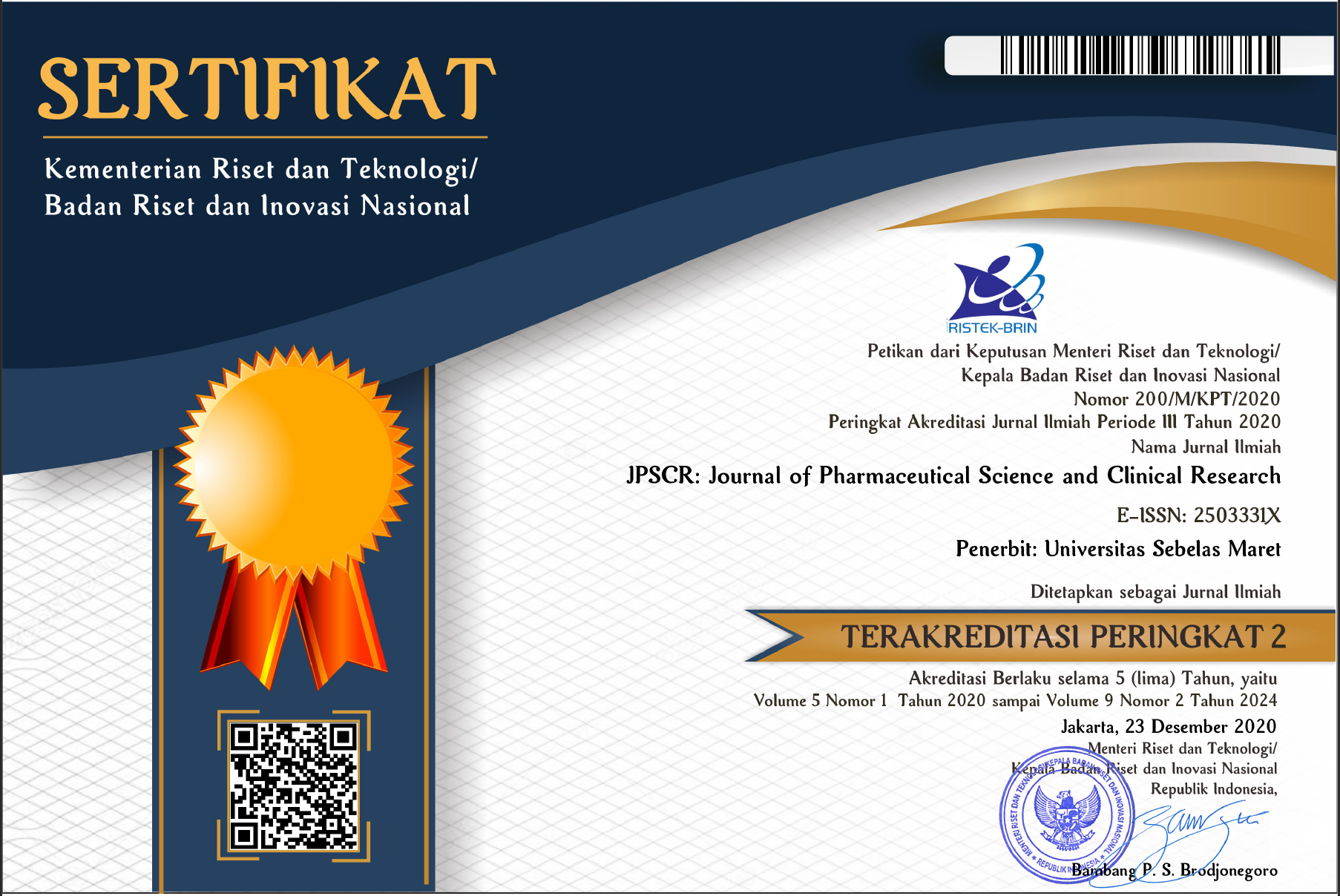Potensi Daun Keji beling (Strobilanthus crispus) sebagai Antibakteri dan Antibiofilm terhadap Bakteri Cutibacterium acnes
Abstract
Keywords
Full Text:
PDFReferences
Adriana, L., Dewi, C., & Nasir, N. H. (2023). Uji Aktivitas Antibakteri Ekstrak Etanol Daun Keji beling (Strobilanthes crispa BI) Terhadap Pertumbuhan Bakteri Staphylococcus epidermidis dan Pseudomonas aeruginosa. Jurnal Pharmacia Mandala Waluya, 2(3), Article 3. https://doi.org/10.54883/jpmw.v2i3.82
Ahmed, M. E., Ahmed, Z. M., & Thamer, A. (2020). The Evolutionary Effects of Bacillin and S-Pyocin Bacteriocin and Their Effects on Propionibacterium acnes and Fungi. Biochem. Cell. Arch., 20(2), 3645–3649. https://www.researchgate.net/publication/344616801
Alibi, S., Crespo, D., & Navas, J. (2021). Plant-Derivatives Small Molecules with Antibacterial Activity. Antibiotics, 10(3), 231. https://doi.org/10.3390/antibiotics10030231
Coenye, T., Spittaels, K.-J., & Achermann, Y. (2022). The role of biofilm formation in the pathogenesis and antimicrobial susceptibility of Cutibacterium acnes. Biofilm, 4, 100063. https://doi.org/10.1016/j.bioflm.2021.100063
Dong, G., Liu, H., Yu, X., Zhang, X., Lu, H., Zhou, T., & Cao, J. (2018). Antimicrobial and anti-biofilm activity of tannic acid against Staphylococcus aureus. Natural Product Research, 32(18), 2225–2228. https://doi.org/10.1080/14786419.2017.1366485
Fardiyah, Q., Suprapto, Kurniawan, F., Ersam, T., Slamet, A., & Suyanta. (2020). Preliminary Phytochemical Screening and Fluorescence Characterization of Several Medicinal Plants Extract from East Java Indonesia. IOP Conference Series: Materials Science and Engineering, 833(1), 012008. https://doi.org/10.1088/1757-899X/833/1/012008
Feuillolay, C., Pecastaings, S., Gac, C. L., Fiorini-Puybaret, C., Luc, J., Joulia, P., & Roques, C. (2016). A Myrtus communis extract enriched in myrtucummulones and ursolic acid reduces resistance of Propionibacterium acnes biofilms to antibiotics used in acne vulgaris. Phytomedicine, 23(3), 307–315. https://doi.org/10.1016/j.phymed.2015.11.016
Fissy, S. O. F., Sari, R., & Pratiwi, L. (2014). Efektivitas Gel Anti Jerawat Ekstrak Etanol Rimpang Jahe Merah (Zingiber officinale Rosc. Var. Rubrum) terhadap Propionibacterium acnes dan Staphylococcus epidermidis. Jurnal Ilmu Kefarmasian Indonesia, 12(2), 193–201. http://jifi.farmasi.univpancasila.ac.id/index.php/jifi/article/view/148
Górniak, I., Bartoszewski, R., & Króliczewski, J. (2019). Comprehensive review of antimicrobial activities of plant flavonoids. Phytochemistry Reviews, 18(1), 241–272. https://doi.org/10.1007/s11101-018-9591-z
Guzzo, F., Scognamiglio, M., Fiorentino, A., Buommino, E., & D’Abrosca, B. (2020). Plant Derived Natural Products against Pseudomonas aeruginosa and Staphylococcus aureus: Antibiofilm Activity and Molecular Mechanisms. Molecules, 25(21), 5024. https://doi.org/10.3390/molecules25215024
Hong, W., Zeng, J., & Xie, J. (2014). Antibiotic drugs targeting bacterial RNAs. Acta Pharmaceutica Sinica B, 4(4), 258–265. https://doi.org/10.1016/j.apsb.2014.06.012
Jahns, A. C., & Alexeyev, O. A. (2014.). Three dimensional distribution of Propionibacterium acnes biofilms in human skin—Jahns—2014—Experimental Dermatology—Wiley Online Library. Retrieved December 31, 2023, from https://onlinelibrary.wiley.com/doi/10.1111/exd.12482
Kaczmarek, B. (2020). Tannic Acid with Antiviral and Antibacterial Activity as A Promising Component of Biomaterials—A Minireview. Materials, 13(14), 3224. https://doi.org/10.3390/ma13143224
Kementerian Kesehatan RI. (2017). Farmakope Herbal Indonesia Edisi II. Kementerian Kesehatan Republik Indonesia.
Kim, Y.-G., Lee, J.-H., & Lee, J. (2021). Antibiofilm activities of fatty acids including myristoleic acid against Cutibacterium acnes via reduced cell hydrophobicity. Phytomedicine, 91, 153710. https://doi.org/10.1016/j.phymed.2021.153710
Kusuma, I. W., Rahmini, Arung, E. T., Pramono, A. Y., Erwin, & Supomo. (2020). Biological activities and phytochemicals of Hyptis capitata grown in East Kalimantan, Indonesia. Journal of Applied Biology & Biotechnology, 8(2), 58–64. https://doi.org/10.7324/JABB.2020.80210
Lahiri, D., Dash, S., Dutta, R., & Nag, M. (2019). Elucidating the effect of anti-biofilm activity of bioactive compounds extracted from plants. Journal of Biosciences, 44(2), 52. https://doi.org/10.1007/s12038-019-9868-4
Lim, V., Yap, C. S., Chong, H. W., Shukkoor, M. S. A., & Priya, M. (2015). Antimicrobial Evaluation and GC-MS Analysis of Strobilanthes crispus Ethanolic Leaf Extract. European Journal of Medicinal Plants, 10(4), 1–8. https://doi.org/DOI: 10.9734/EJMP/2015/20075
Linfante, A., Allawh, R. M., & Allen, H. B. (2017). The Role of Propionibacterium acnes Biofilm in Acne Vulgaris. Journal of Clinical & Experimental Dermatology Research, 09(01). https://doi.org/10.4172/2155-9554.1000439
Luchian, I., Goriuc, A., Martu, M. A., & Covasa, M. (2021). Clindamycin as an Alternative Option in Optimizing Periodontal Therapy. Antibiotics, 10(7), 814. https://doi.org/10.3390/antibiotics10070814
Mustarichie, R., Sulistyaningsih, S., & Runadi, D. (2020). Antibacterial Activity Test of Extracts and Fractions of Cassava Leaves (Manihot esculenta Crantz) against Clinical Isolates of Staphylococcus epidermidis and Propionibacterium acnes Causing Acne. International Journal of Microbiology, 2020, e1975904. https://doi.org/10.1155/2020/1975904
Ng, M. G., Ng, C. H., Ng, K. Y., Chye, S. M., Ling, A. P. K., & Koh, R. Y. (2021). Anticancer Properties of Strobilanthes crispus: A Review. Processes, 9(8), 1370. https://doi.org/10.3390/pr9081370
Samsulkahar, N. F., Hadi, A. A., Shamsuddin, M., & Malek, N. A. N. N. (2023). Biosynthesis of Gold Nanoparticles Using Strobilanthes crispa Aqueous Leaves Extract and Evaluation of Its Antibacterial Activity. Biointerface Research in Apllied Chemistry, 13(1), 1–16. https://doi.org/10.33263/briac131.063
Sangani, M. H., Moghaddam, M. N., & Mahdi, M. (2015). Inhibitory effect of zinc oxide nanoparticles on Pseudomonas aeruginosa. Nano Medicine Journal 2(2): 121-128. https://nmj.mums.ac.ir/article_4091_f60dfe6f0686f44e38fe15650fae8754.pdf
Stefan, R., Hobden, J. A., Miller, S., Morse, S. A., Mietzner, T. A., Detrick, B., Mitchell, T. G., Sakarani, J. A., Hotez, P., & Mejia, R. (2019). Jawetz, Melnick & Adelbreg’s: Medical Microbiology (28th ed.). McGraw Hill.
Suproborini, A., Laksana, M. S. D., & Martiningsih, S. H. (2022). Uji Efektivitas Antibakteri Ekstrak Daun Stobilanthes crispus Terhadap Pseudomonas aeruginosa. Journal of Pharmaceutical Science and Medical Research, 5(1), 25–32. DOI: http://doi.org/10.25273/pharmed.v5i1.12460.
Suproborini, A., Laksana, M. S. D., & Puspita, W. (2023). Strobilanthes crispus antibacterial against Aggregatibacter actinomycetecomitans. Asian Journal of Management, Entrepreneurship and Social Science, 3(03), 1150 – 1160. http://www.ajmesc.com/index.php/ajmesc/article/view/517/312
Taleb, M. H., Abdeltawab, N. F., Shamma, R. N., Abdelgayed, S. S., Mohamed, S. S., Farag, M. A., & Ramadan, M. A. (2018). Origanum vulgare L. Essential Oil as a Potential Anti-Acne Topical Nanoemulsion—In Vitro and In Vivo Study. Molecules, 23(9), 2164. https://doi.org/10.3390/molecules23092164
Wardani, H. N. (2020). Potensi Ekstrak Daun Sirsak Dalam Mengatasi Kulit Wajah Berjerawat. Jurnal Penelitian Perawat Profesional, 2(4), 563–570. DOI: https://doi.org/10.37287/jppp.v2i4.218
Yurlina Zai, Agnes Yohana Kristino, Sri Lestari Ramadhani Nasution, & Oliviti Natali. (2019). Uji Efektivitas Antibakteri Ekstrak Daun Sirsak (Annona muricata Linn,) Terhadap Bakteri Propionibacterium acnes. Jurnal Biologi Lingkungan, Industri, Kesehatan, 6(1), 59–64. https://doi.org/10.31289/biolink.v6i1.2244Refbacks
- There are currently no refbacks.





